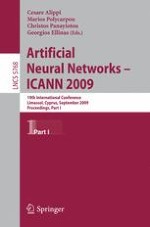This volume is part of the two-volume proceedings of the 19th International Conf- ence on Artificial Neural Networks (ICANN 2009), which was held in Cyprus during September 14–17, 2009. The ICANN conference is an annual meeting sp- sored by the European Neural Network Society (ENNS), in cooperation with the - ternational Neural Network Society (INNS) and the Japanese Neural Network Society (JNNS). ICANN 2009 was technically sponsored by the IEEE Computational Intel- gence Society. This series of conferences has been held annually since 1991 in various European countries and covers the field of neurocomputing, learning systems and related areas. Artificial neural networks provide an information-processing structure inspired by biological nervous systems. They consist of a large number of highly interconnected processing elements, with the capability of learning by example. The field of artificial neural networks has evolved significantly in the last two decades, with active partici- tion from diverse fields, such as engineering, computer science, mathematics, artificial intelligence, system theory, biology, operations research, and neuroscience. Artificial neural networks have been widely applied for pattern recognition, control, optimization, image processing, classification, signal processing, etc.
